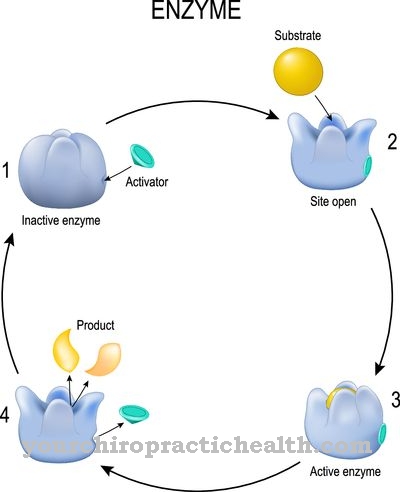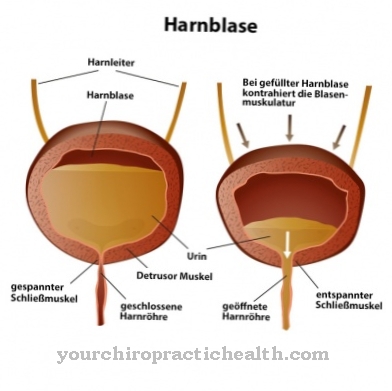The Endometriosis is a Overgrowth of the uterine liningwhich, due to the symptoms and the limitation of the disease in the area of the uterus on the basis of the decisive anatomical conditions, only affects women.
What is endometriosis?

With endometriosis, the affected women suffer from an overgrowth of tissue that manifests itself in the mucous membrane outside the uterus. Endometriosis affects the endometrium, the lining of the uterus.
Endometriosis is caused by benign growths on the mucous membrane that do not cause metastases. The endometriosis is characterized by sometimes quite severe painful impairments. Endometriosis is not only typical of the areas around the uterus.
Endomeriosis can also develop on the peritoneum in the small pelvis, on the so-called retaining straps of the uterus and on the ovaries. Endometriosis is also found quite often in the Douglas space. This area marks the deepest zone in the abdomen behind the uterus. Endometriosis is a proliferative abnormality that, if left untreated, is characterized by further growth.
causes
Despite extensive research, the causes for the development of endometriosis are not yet clearly known. Only numerous risk factors can have a direct influence on the development of endometriosis. It is assumed that endometriosis is a term for daughter tumors from another cancer focus.
It is also recognized that cells from inside the uterus reach the outer mucous membranes and contribute to endomtriosis there.
The processes in the ovaries known as retrograde menstruation can possibly contribute to endometriosis by shedding cells from the uterine lining. A weakened or altered immune system can also be a causal trigger for endometriosis.
Symptoms, ailments & signs
Only half of all women affected have endometriosis symptoms. The symptoms that the other half of sufferers experience depend on where the endometriosis is in the body. The endometrial foci, like the regular mucous membrane of the uterus, are subject to cycle-related changes. Accordingly, complaints mainly occur depending on the cycle.
Whether and how pronounced the symptoms are varies from case to case and is not necessarily related to the size or number of the herd. A large proportion of the patients are completely symptom-free and the endometriosis is only an incidental finding. The main symptom of endometriosis is in the second half of the cycle, sometimes very severe, cramp-like pain during and after the period. These are known as dysmenorrhea.
In addition, the menstrual period may be increased or there may be intermenstrual bleeding. Depending on the location of the foci of the mucous membrane, other very different symptoms arise. These include pain during sexual intercourse and during gynecological examinations, pain during bowel movements or pain when urinating, cycle-dependent bleeding from the bladder or intestines, nausea and circulatory problems.
Women with endometriosis are far more likely to be sterile than healthy women. During a medical examination, cysts, adhesions and scars can be found in the affected tissue. The large number of possible symptoms and the different manifestations of the symptoms make the diagnosis difficult and the disease is often discovered late.
Diagnosis & course
Due to the varied and sometimes severe symptoms and complaints of terminal metriosis, the women go to a specialist who can perform a laparoscopy to confirm the assumption. In addition, due to the rather unspecific symptoms of endometriosis, further diagnostic information such as the observation of the menstruation with regard to a painful course, pain in the lower back and during sexual contact as well as disturbances in the menstrual cycle are useful.
Laboratory examinations of the butt and stool as well as the control by the gynecologist can partly represent steps in the diagnosis. So-called imaging techniques such as ultrasound or computed tomography are diagnostically relevant options for clarifying endometriosis. In addition, the tissue samples obtained during the laparoscopy are examined.
The forms of endometriosis vary from person to person. Basically, in the majority of cases, the endometriosis must be removed in order to relieve pain and discomfort and to eliminate the symptoms that occur. If left untreated, endometriosis can lead to infertility.
Complications
Since endometriosis is a chronic disease, the symptoms are always recurring. Without treatment, the symptoms usually worsen. The spread of the uterine lining can increase both with and without treatment. This increases the symptoms and other parts of the body can also be affected.
In addition to the cyclically recurring pain, the possible connection to female infertility is a complication. Even if there is no scientific confirmation, studies still show that the fertility rate of women suffering from endometriosis is significantly reduced. Without treatment, an existing desire to have children may remain unfulfilled.
Treatment is usually carried out by giving hormones. Complications can occur in a variety of ways, as the hormones control all body functions. The administration of estrogens can lead to weight gain and skin reactions. The risk of thrombosis for the women affected also increases. Hot flashes and sweats as well as reduced bone density are possible side effects of the hormone administration.
If parts of the uterine lining are scattered over a large area, an operation is carried out. Problems can arise as complications during or after anesthesia, the risk of infection is increased and scarring occurs. The adhesions at the interfaces can also cause pain. Alternative medical support measures such as mud packs, massages and relaxation techniques such as yoga run without complications.
When should you go to the doctor?
Women who have severe menstrual pain or other menstrual cramps should consult a doctor. If lower back pain or pain during intercourse occurs, this indicates a serious condition that needs to be clarified. The doctor can determine whether this is endometriosis and, if necessary, initiate treatment immediately. If there is an unfulfilled desire to have children, this must also be clarified. There may be a previously unrecognized endometriosis that led to infertility.
Rapid treatment can possibly dissolve the growth and restore fertility. People who have had cancer in the past are particularly susceptible to endometriosis. A weakened or altered immune system can also promote proliferation of the uterine lining. If these risk factors are present, the gynecologist should be consulted quickly with the symptoms mentioned. Other contacts are internists or - in the event of a medical emergency - the ambulance service. Infertility may have to be dealt with with a therapist.
Doctors & therapists in your area
Treatment & Therapy
There are various methods and procedures available to doctors for treating endometriosis. However, treatment is not absolutely necessary for every woman.
The two pillars of endometriosis therapy are drug and surgical treatment. With the operation, women affected by endometriosis are finally relieved of symptoms. The surgical intervention against endometriosis is based on a laparoscopy or laparoscopy. This procedure can enable laser-assisted exfoliation of the endometriosis.
In some cases, the endometriosis can be removed through the vagina. An abdominal incision is usually justified if the endometriosis cannot otherwise be reached. This method is only carried out once the family planning is complete, since the abdominal incision mostly includes the removal of the ovaries at the same time.
For the therapy of endometriosis with drugs, progestins and drugs known as GnRh antagonists are administered. The prescribed drugs usually have to be taken over a longer period of time, usually over half a year, for the intended effect.
Outlook & forecast
According to current medical standards, endometriosis cannot be completely cured and difficulties can arise again and again in the course of the life of an affected patient. There are also some cases of endometriosis in which the affected woman has no symptoms for a lifetime.
If an endometriosis focus spreads or a new focus develops, new symptoms or a worsening of existing symptoms must be expected. Depending on the severity and level of suffering of the patient, surgical removal of the endometriosis focus may be necessary, which eliminates the symptoms. However, this only lasts until there is another problematic focus in the body.
Problems also arise when women with endometriosis try to get pregnant.Endometriosis limits fertility; in some cases natural fertilization is even completely impossible. Affected women still have the option of artificial insemination, but even then pregnancy may not occur or the pregnancy may be terminated in the first few days and weeks.
If, on the other hand, the pregnancy persists and the child is born, the endometriosis may improve after the birth and the woman will then have to struggle with less severe symptoms or no symptoms at all.
prevention
There are no known ways to prevent endometriosis. This would only be possible if the causal triggers could be sufficiently localized. However, as part of targeted self-observation, the women are able to realize early detection of endometriosis. If you have irregular menstruation, such as persistent and recurring symptoms during or between your menstrual period, we recommend talking to your gynecologist.
Aftercare
Many women with endometriosis have to have surgery to remove the painful growths of the uterine lining. Under certain conditions, these can spread throughout the body. Depending on where the knots were removed, an overgrowth can develop. Alternatively, there may be other postoperative consequences. Both may require follow-up care.
When cells from the lining of the uterus settle in the body, it causes pain. These are not always given to an acceptable extent. Endometriosis can also lead to infertility. Nevertheless, there is no need for treatment if the endometriosis causes little or no discomfort. In this case, there is no aftercare.
It looks different, however, when the lining of the uterus settles on the intestinal wall, on organs or even in the eye. In this case, operational options must be discussed. In addition, the resulting pain can be treated psychotherapeutically and thereby alleviated.
Treatment with painkillers or hormone preparations should be closely monitored for follow-up care. Both can lead to consequences such as addiction and dependency or an increased risk of thrombosis or embolism. The woman's age therefore plays a decisive role in the treatment and follow-up measures chosen. A hysterectomy may be indicated at an advanced age. As a rule, this operation is only followed by post-operative follow-up.
You can do that yourself
In endometriosis, the lining of the uterus forms outside the uterine cavity, which is often associated with enormous pain for the women affected. The patients cannot take self-help measures that combat the cause of the problem.
The most important step towards self-help is to work towards a swift diagnosis and adequate medical treatment. Women who suffer from severe pain during menstruation should by no means accept this as "natural", but should always consult a gynecologist. If endometriosis is actually diagnosed, there are a number of treatment options.
Patients should then obtain comprehensive information from an expert about all possible therapy options. Gynecologists who specialize in the treatment of endometriosis can be researched on the Internet, and the medical associations and health insurance companies provide information on this.
During an acute attack, affected women should take it easy and spend a day in bed. Often times, a hot water bottle on the stomach provides relief. Chemical hand warmers that can be discreetly placed under clothing help on the go and at work.
For endometriosis, naturopathy recommends intestinal rehabilitation followed by a change in diet towards a largely plant-based diet with a high proportion of raw food. There is no scientific research into the effectiveness of this treatment method for endometriosis. Since a balanced, plant-based diet is generally beneficial for your health, nothing speaks against trying.


.jpg)





















.jpg)



